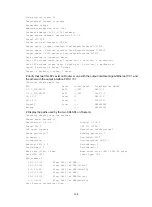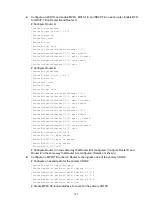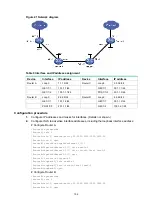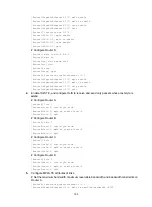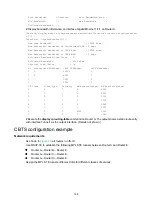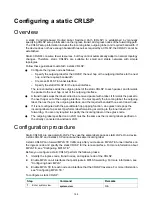
151
2.2.2.1/1/16802 RSVP -/1151 GE1/1/2
Backup -/3 Tun50
2.2.2.2/50/16802 RSVP -/3 POS1/1/1
3.2.1.2 Local -/- POS1/1/1
3.3.1.2 Local -/- POS1/1/0
# Display detailed information about MPLS TE tunnel 1 (the tunnel for the primary CRLSP) on Router
B. The output shows that Tunnel1 is protected by the bypass tunnel Tunnel50, and the protected
node is 3.1.1.1.
[RouterB] display rsvp lsp tunnel-id 1 verbose
Tunnel name: Tunnel1
Destination: 4.4.4.4 Source: 1.1.1.1
Tunnel ID: 1 LSP ID: 16802
LSR type: Transit Direction: Unidirectional
Setup priority: 7 Holding priority: 7
In-Label: 1150 Out-Label: 1151
In-Interface: GE1/1/1 Out-Interface: GE1/1/2
Nexthop: 3.1.1.2 Exclude-any: 0
Include-Any: 0 Include-all: 0
Average bitrate: 0 kbps Maximum burst: 1000.00 bytes
Path MTU: 1500 Class type: CT0
RRO number: 12
2.1.1.1/32 Flag: 0x00 (No FRR)
2.1.1.2/32 Flag: 0x00 (No FRR)
1150 Flag: 0x01 (Global label)
2.2.2.2/32 Flag: 0x20 (No FRR/Node-ID)
3.1.1.1/32 Flag: 0x09 (FRR Avail/Node-Prot)
3.1.1.2/32 Flag: 0x00 (No FRR)
1151 Flag: 0x01 (Global label)
3.3.3.3/32 Flag: 0x20 (No FRR/Node-ID)
4.1.1.1/32 Flag: 0x00 (No FRR)
4.1.1.2/32 Flag: 0x00 (No FRR)
3 Flag: 0x01 (Global label)
4.4.4.4/32 Flag: 0x20 (No FRR/Node-ID)
Fast Reroute protection: Ready
FRR inner label: 3 Bypass tunnel: Tunnel50
IETF DS-TE configuration example
Network requirements
Router A, Router B, Router C, and Router D run IS-IS and all of them are Level-2 routers.
Use RSVP-TE to establish an MPLS TE tunnel from Router A to Router D to transmit data between
the two IP networks. Traffic of the tunnel belongs to CT 2, and the tunnel needs a bandwidth of 4000
kbps.
The maximum bandwidth of the link that the tunnel traverses is 10000 kbps and the maximum
reservable bandwidth of the link is 10000 kbps. BC 1, BC 2, and BC 3 are 8000 kbps, 5000 kbps, and
2000 kbps.


